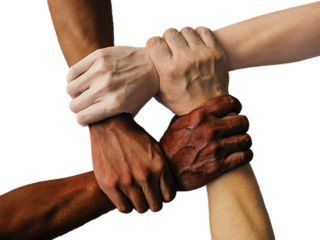Resilience
Building Resilient Communities in Times of Adversity
We must learn how to get along, and here's how.
Posted January 2, 2018

We find ourselves in what may be considered the most chaotic time in the post-9/11 era. Disasters, terrorism, political dysfunction, economic concerns, and a fraying of an already tattered social fabric serve as our springboard for at least the immediate future. Surely these factors portend a challenging future unless constructive change can emerge.
If ever there was a time to turn our focus on building resilient and sustainable communities, it’s now.
“People, I just want to say, you know, can we all get along? Can we get along?" With these words spoken on May 1st, 1992, Rodney King appealed for calm in the midst of what would become known as the Los Angeles riots. Few people would argue against the notion of improving community relations and community resilience, the question has simply been, how? Charles Darwin, in 1859, argued that cohesive communities were resilient communities, and resilient communities were those deemed most sustainable (Darwin, 1859).

LESSONS LEARNED
Retrospective qualitative reviews can prove useful in revealing factors that promote community resilience in the wake of adversity. Two such noteworthy reviews are those of Zinner & Williams (1999) and Kilmer, et al. (2010). In their collective studies of community challenges and disasters, 10 factors that seem to foster community resilience emerged:
- Resilience-oriented leadership
- Adequate community resources
- Critical incident stress management psychological interventions
- Rituals of memorialization and closure
- A shared perception of the nature and gravity of the stressor event/disaster and a shared commitment to recovery
- Connectivity within the community
- Communications
- Shared community values
- Emergent heroism
- Social cohesion
The observations of Darwin over 100 years earlier seem to have been confirmed. Cohesive communities are resilient communities.
FACTORS THAT ERODE RESILIENCE
On the other hand, there appear to be factors which fuel the adverse impact of stressors upon a community. They include:
- Protracted incidents
- Domestic dislocation
- Mistrust of leadership
- Lack of predictability
- Inadequate recovery resources
- Human-caused
- Child-related
- Poor communications
- Misleading communications
- Preventability of the event
- A large number of fatalities
FACTORS THAT BUFFER ADVERSITY
In the quest to find the ingredients of community resilience, we can easily fall prey to getting lost in the trees and failing to recognize the forest within which we dwell. We can become exclusively reactionary. To avoid that mistake, a brief comment regarding intrinsic socio-cultural protective factors seems warranted. Reviews of communities impacted by violence, terrorism, war, and disasters have revealed three overarching factors which appear to buffer or protect against adversity. These are broad socio-cultural themes that serve as a platform for the community. They serve in many ways to define the atmosphere of the community. They include a pervasive sense of equal opportunity, a belief in community justice, and social cohesion.
BUILDING COMMUNITY COHESION: “The Seven Cs”
If indeed the observations of Darwin are correct, that cohesive communities are resilient communities, then how do we foster increased social cohesion, specifically in the wake of adversity?
Command and Control – Community leadership must exert authority and direction during and after community adversity. The implementation of “resilient leadership” principles (Everly, Strouse, & Everly, 2010) can be useful (Institute of Medicine, 2012).
Communication – Credible and timely communication is one way by which command and control are affected. This is especially important in the age of social media. If leadership is not communicating, someone else is. At that point leadership will have lost much of its effectiveness.
Connectedness – This refers to the inclination and ability of subgroups within the community to communicate.
Commitment – This refers to a shared commitment to pursue that which is in the best interest of the community, rather than communal subgroups. An analysis of the famous Robbers’ Cave experiment is revealing.
Context – This refers to an atmosphere of shared constructive values within the community. A review of the “Broken Windows” research may be useful here.
Collaboration and Cooperation – Based upon an integration of connectedness, leadership communications, commitment, shared values, collaboration and cooperation should be enhanced.
Competence – This factor refers to the intrinsic short-term agency, or short-term self-efficacy of the community. This is sometimes called the “battleship effect,” wherein a battleship, by design, has the resources and training to be self-reliant for a short period of time absent the support of the fleet. Thus, so too should communities prepare for short-term self-reliance, with the subsequent ability to continue the recovery process after external resources have been withdrawn.

Socially cohesive communities are resilient and self-sustaining. During epochs of unpredictability, mistrust, and divisiveness, as well as in the wake of acute adversity and disaster, we must find ways to sustain ourselves and future generations. Building resilience may be an essential element in that quest.
© George S. Everly, Jr., PhD
References
Darwin, Charles (1859). On the Origin of Species by Means of Natural Selection. London: John Murray.
Everly, G.S., Jr., Strouse D., & Everly, G.S., III (2010). Resilient Leadership. NY: DiaMed.
Institute of Medicine. (2012). Building a Resilient Workforce: Opportunities for the Department of Homeland Security: Workshop Summary. Washington, DC: The National Academies Press. https://doi.org/10.17226/13380
Kilmer, R., Gil-Rivas, V., Tedeschi, R., & Calhoun, L. (Eds.).(2010). Helping Families and Communities Recover from Disaster. Washington, DC: APA Press.
Zinner, E. & Williams, M.B. (Eds.).(1999). When a Community Weeps. Philadelphia: Brunner/Mazel.


